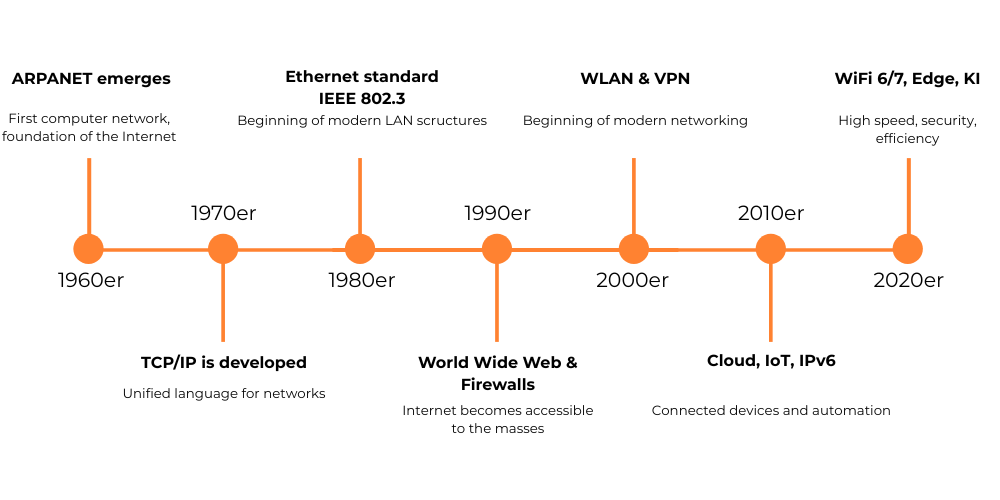
The 1960s: First Steps in Networking
In the 1960s, the history of network technology began with an experiment that would make history: the ARPANET. In 1969, it connected four universities in the United States and enabled the first transmission of data over long distances. The project was launched by the U.S. Advanced Research Projects Agency (ARPA).
Its foundation was packet switching, a method in which information is divided into small units, sent through different routes, and reassembled at the destination.
Although initially intended for research and military purposes, it laid the groundwork for what would later become the Internet. Networks at that time were cumbersome, slow, and expensive—but they worked.
The 1970s: Structure and Standards
As computers became more widespread, the need to connect them reliably grew. Two developments defined this decade: the TCP/IP protocol and Ethernet.
Vinton Cerf and Robert Kahn developed TCP/IP in 1974—a universal language that made data transmission possible regardless of device type. At the same time, Robert Metcalfe at Xerox worked on Ethernet, which enabled local communication between computers and was first put into operation in 1973.
With that, the foundation for modern networks was laid: faster connections, compatible systems, and the ability to operate multiple computers within a shared network.
The 1980s: Networks Conquer Businesses
The 1980s were the decade when network technology entered everyday business life. With the OSI reference model, a clear system was established that divided communication processes into seven layers which reach from physical transmission up to application. OSI stands for Open Systems Interconnection. This structure still shapes how networks are planned and built today.
At the same time, the first hardware components such as switches, routers, and firewalls hit the market, ensuring that networks not only functioned but also became more secure.
A comparison shows how these devices have evolved:
These advancements made networks economically significant for the first time—laying the foundation for modern business communication.
The 1990s: The Internet for Everyone
With the introduction of the World Wide Web in 1991, network technology became accessible to the masses. The number of connected computers grew explosively, and browsers like Mosaic and Netscape made the Internet available to everyone.
At the same time, security came into sharper focus—firewalls became standard to protect corporate networks from attacks.
Physical infrastructure also evolved: coaxial cables were replaced by twisted-pair connections, allowing higher transmission rates. Ethernet reached 100 Mbit/s and finally established itself as the global standard.
The 2000s: The Beginning of Mobile Networking
With the turn of the millennium began the age of wireless networks. WLAN standards such as 802.11b and 802.11n made mobile work possible for the first time. Companies used VPNs to provide employees with secure remote access, paving the way for flexible work models.
Networks became more complex: alongside desktop PCs came laptops, smartphones, and the first IoT devices (Internet of Things). This created higher demands on bandwidth, stability, and IT security—forcing network developers to keep up.
They succeeded: speed, scalability, and security became the buzzwords of the era, and innovations were almost a daily occurrence. Faster, higher, further? Silicon Valley, as the breeding ground of modern tech companies, boomed like never before, and the race for the most advanced network technology resembled a Formula 1 competition.
The 2010s: Intelligent Networks
From 2010 onward, the focus shifted from hardware to software. With Software Defined Networking (SDN) and Cloud Computing, network infrastructures became dynamic, adaptable, and location-independent.
At the same time, the Internet of Things (IoT) expanded—billions of devices became interconnected, from sensors to servers. Since the IPv4 address space was no longer sufficient, IPv6 became the new standard.
Automation, virtualization, and cloud-based security solutions shaped everyday business life—networks became not only faster but also smarter.
The Present: Speed Meets Sustainability
Today, network technology stands for high performance, security, and energy efficiency. Technologies such as WiFi 6, WiFi 7, fiber-optic backbones, and edge computing enable real-time data transmission and turn modern networks into highly complex ecosystems.
At the same time, awareness of sustainability is growing. More and more companies rely on refurbished hardware to save resources and reduce costs. As a result, the lifespan of devices and the topic of reconditioning have become central aspects of modern IT infrastructure.
The Future: Networking Without Limits
Networks of the future will be self-learning, autonomous, and more secure than ever. Artificial intelligence will analyze data flows, detect errors, and automatically optimize systems.
New technologies such as 5G, 6G, and quantum communication will once again revolutionize speed and range. The goal is a global infrastructure that connects people, machines, and data in real time - efficiently, stably, and, ideally, resource-efficiently.
Conclusion: Network Technology as the Backbone of Digitalization
From the first data lines of the 1960s to intelligent cloud networks, the evolution of network technology mirrors technological progress itself. It has fundamentally changed the way we work, communicate, and think. Without it, modern digitalization would be unimaginable.
Network technology remains the backbone of the IT world. Yesterday, today, and tomorrow.
Your Partner for Modern Network Technology
Whether router, switch, or firewall, at IT-Market.com, you’ll find a wide selection of new and refurbished devices from leading manufacturers. Our certified technicians carefully inspect and professionally recondition every component. We also offer up to 3 years of warranty for B2B customers.
Planning an upgrade or expanding your infrastructure? Our team will be happy to provide expert, personalized advice tailored to your needs.
